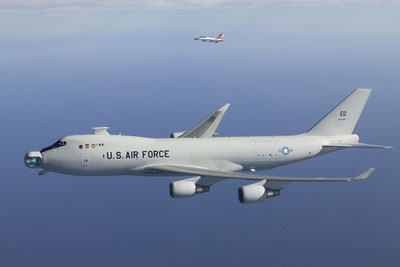America’s new ray gunsby Taylor Dinerman
|
| To ordinary Americans, the whole idea of beam weapons seems more like science fiction. |
Ever since lasers were developed in the early 1960s, there has been the expectation that they would be used someday as weapons. Indeed, the word “phaser”, used on the TV show Star Trek, was merely a corruption of the word “laser.” Over the last few decades, there has been any number of military laser demonstration projects. The power and sophistication of these systems improved to the point that, by the early 1990s, the Department of Defense decided to go ahead with an operational anti-missile weapon, the ABL.
The ABL is a chemical oxygen-iodine laser mounted on a Boeing 747 and designed to shoot down Scud-type missiles in their initial boost phase at ranges of more than 100 kilometers. The US Air Force hopes to build seven of these aircraft so that a team of four could provide ongoing 24-hour-a-day coverage of an enemy launch area over a period of some weeks. The ABL program does not involve any major scientific or technological breakthroughs—it is the first of its kind and, as such, has run into the normal delays and difficulties.
The true potential for this weapons system can, so far, only be guessed at. As Beason points out, “The only problem is that no one knows for sure what other missions the ABL is capable of performing.” In one interesting scenario, the author speculates how it might be used against a terrorist cruise missile attack on a US city. Other possibilities might even include “tickling” space debris in low Earth orbit (LEO), in order to bring it down sooner than would otherwise be the case. Serious experimentation will begin no sooner than 2008. Only last month did the USAF review board give the go-ahead to actually install the laser mechanism in the prototype aircraft.
The ABL is not the only laser weapon the Defense Department is working on, though it is the most advanced. In the mid-1990s, after Israel’s pullout from southern Lebanon, the US and Israel began collaborating on a laser system that would shoot down small artillery and mortar shells as well as short range rockets of the Katyusha type. Referred to as the Mobile-Tactical High Energy Laser (M-THEL), an early, immobile, version has been in testing since the late 1990s. While the experiments have been successful, turning it into an operational system will be a long and expensive process. Israel would like to have such a weapon in the very near future for use against rocket attacks from Gaza and Lebanon.
Aside from lasers, high-powered microwaves (HPM) is the other type of directed energy weapons now coming into use. HPM systems originated with the Air Force’s Advanced Concepts group. They tried—and failed—to make artificial lightning bolts. In the 1970s and 1980s, researchers who were working on the charged particle beam concept found that HPMs could be generated and could in fact produce some, but not all, of what they had been hoping to achieve.
Some military experts thought that an early version of these would be used during the 2003 attack on Saddam. One can speculate that the planners at the Pentagon and at Central Command saw no urgent reason to use these, since the Iraqi air defense system was fairly easily overcome without them. Why expose a capability to world scrutiny unnecessarily?
Beason provides his readers with a useful primer on how these microwaves can be used to disable or destroy enemy electronic systems. He makes the case that old-fashioned jamming is no longer as effective as it once was against radars that now can change frequencies “in a few thousandths of a second.” He writes that, “Instead of trying to defeat the enemy by making miniscule improvements in electronic warfare that you hope the enemy won’t notice, using HPM is like kicking down the door and throwing in a grenade.”
| Solid-state lasers are the ideal space weapons, but this technology is in its infancy and it will be many years before it’s ready. |
Both of these types of devices may be ideal space weapons due to the lack of any atmosphere that might interfere with beam propagation. Some of the proposed ideas have lacked any realism, such as the Space Based Laser experiment, which was canceled a couple of years ago. Beason is properly skeptical of such ideas and makes a good case for using an Earth-based laser, with reflectors in space. “…the problems associated with fielding a relay mirror, though non trivial, seem small.” Solid-state lasers are the ideal space weapons, but this technology is in its infancy and it will be many years before it’s ready.
In the meantime, lower powered lasers may have some limited uses as defensive systems attached to satellites, or as sensors. HPM systems, on the other hand, may be much easier to deploy within a reasonable timeframe. These could disable enemy spacecraft without producing the debris problems that have concerned proponents and opponents of space weapons, alike.
Beason’s book is a valuable introduction to this new class of weaponry. While it would have been nice if it were better organized, his work is full of new insights and information of which even well-informed observers might not be aware. Over the next decade, directed energy systems are going to play a greater and greater role in the way wars are fought. The US may have an advantage now, but other nations are working hard to catch up. The US is going to have to pay attention to the damage these weapons can cause our own military and civilian assets and, more important, to protecting our troops from the effects of these weapons on the human body.
